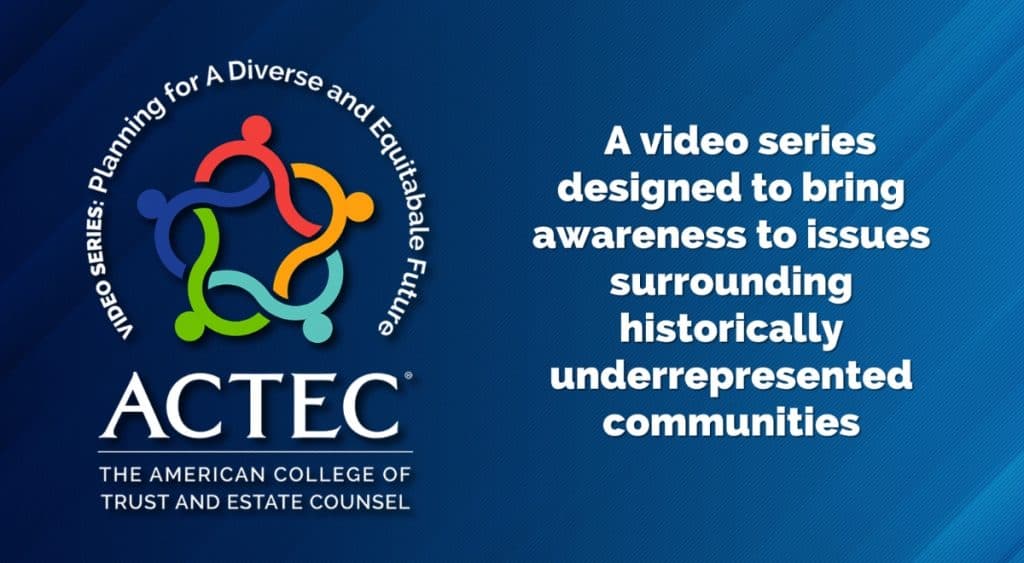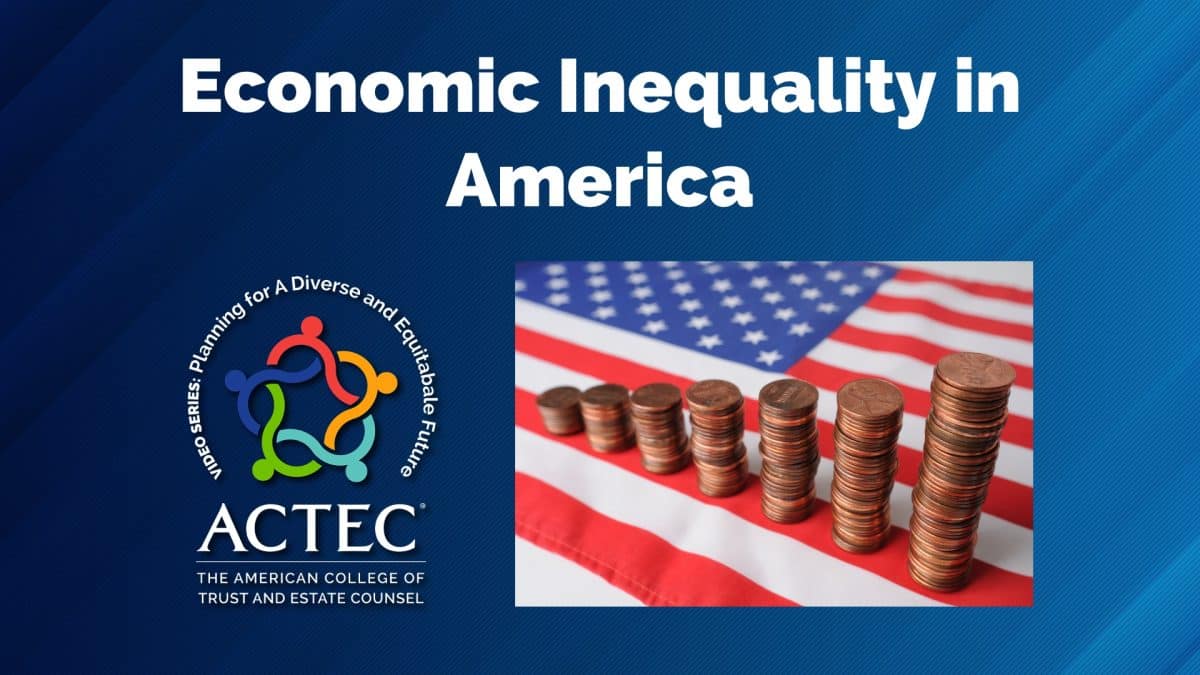“Fair” housing is an unachieved goal in the United States. In the 1930s, the federal government used “red lining” in poor black neighborhoods marking them as “hazardous,” which cut them off from infrastructure investments, banking and finance, and development. Today, the effects of systematic racism are still evident in our society, with prime real estate zoned as single-family housing and the working poor priced out of many cities and communities. The average black American has eight cents for every dollar of wealth that white Americans have. A contributor to this wealth gap is the lack of wealth transfer from generation to generation through many families’ most significant assets, their home.
In this video, Georgetown Law Professor, Dr. Sheryll Cashin discusses her well-researched book White Space, Black Hood: Opportunity Hoarding and Segregation in the Age of Inequality with host ACTEC Fellow Terrence M. Franklin. Wealth management and estate planning professionals have an opportunity to understand the complexities of the issue better and work with black communities to increase wealth transfer for future generations.
“Slums Breed Crime” image courtesy of Wikimedia Commons and U.S. National Archives and Records Administration, Public Domain.

Resources
- White Space, Black Hood: Opportunity Hoarding and Segregation in the Age of Inequality by Sheryll Cashin
- National Low Income Housing Coalition’s Fair Housing Act Overview
- Black Homes Matter
- NPR’s Forgotten History of How the U.S. Government Segregated America
- National Fair Housing Alliance
- ABC News Analysis of Mortgage Lending Data
Transcript
Introduction
Terrence M. Franklin: April is Fair Housing Month. And in honor of Fair Housing month, we are delighted to have with us author, Georgetown professor, and my law school friend, Sheryll Cashin. Professor Cashin’s latest book is White Space, Black Hood: Opportunity Hoarding and Segregation in the Age of Inequality. One of the recurring themes of our series, Planning for a Diverse and Equitable Future, is the racial wealth and equality gap in America. And perhaps you can explain how your book helps shine light on the gap in the residential housing context.
Sheryll Cashin: Well, for every dollar the average white person has in wealth, the average black person has eight cents. And the origin of that wealth gap, or one of the huge contributors to it, is that beginning in the 1930s the federal government marked virtually every black neighborhood in the country as hazardous. And red lined those neighborhoods saying, “We will not insure mortgages in these neighborhoods,” but they rained down that kind of investment and other investments in majority white neighborhoods. Black people were cut out of the largest wealth building subsidy sponsored by the federal government.
And that had repercussions down through the decades and the very same neighborhoods that were red lined to this day, a fed study correlates that with present-day disinvestment and segregation. So, the federal government taught all the institutional actors that affect housing markets and housing values to devalue black-owned properties and avoid them.
Terrence M. Franklin: Wow. It sounds like it’s pretty entrenched and I think you even used the term “residential caste.” What do you mean by that? What supports that idea?
Residential Caste
Sheryll Cashin: Right, so it’s impossible to understand the persistence of racial and economic inequality in this country I argue, without understanding the role of geography. What we have is a system where government at all levels over invests and excludes in affluent white spaces and disinvests and contains and frankly preys on people in high poverty black and brown neighborhoods. And we have decades of history, particularly of politicians, dog-whistling frankly, telling tales about the people who live in the hood to justify extreme segregation. And the biggest tale or myth that’s told often in America is that high opportunity living is earned and hood living is the deserved result of individual bad behavior.
And nothing could be further from the truth. That myth masks decades of intentional segregation and disinvestment in black neighborhoods and it masks all of the systems that are set against people, particularly in high poverty neighborhoods.
Terrence M. Franklin: That’s so tough because we all live with these myths. To some degree, they’re sort of ingrained in us. What do we do to try to break free from those myths? Are there some remedies or strategies that you recommend in your book?
Breaking the Myths of Poverty
Sheryll Cashin: Right. Well, the first thing I recommend is if you don’t mind, please read the book and understand the processes of residential caste. I argue that there are three main anti-black processes that create and maintain this system. One is boundary maintenance, mainly through exclusionary zoning, investing in and retaining segregation. The second is opportunity hoarding. I show countless examples of governments over investing, particularly in infrastructure in high opportunity places.
And frankly, I forgot to mention this, all of the golden infrastructure and nice things that you see in high opportunity places is subsidized by the people who are excluded. Through their gas taxes, their sales taxes, income taxes, right? So, that’s opportunity hoarding.
And then the third process of residential caste is stereotype driven surveillance, facilitated heavily through segregation. Right? You get in majority black neighborhoods a type of policing that would not be tolerated in other neighborhoods. Black people live frankly in a police state. You also get a lot of citizens, civilians I should say, policing black bodies. The worst examples is the kind of vigilantism that ended up killing poor Ahmaud Arbery just for jogging in a majority white neighborhood. Right?
So, what’s the way forward? The beauty once you understand these systemic processes, the way forward is clear. We need to do the opposite. So, inclusionary zoning rather than exclusionary zoning. What I call “green lining” of black neighborhoods rather than red lining. Historically, defunded black neighborhoods should receive priority in new investments, particularly for infrastructure. And I site studies where, even in black led cities, when they actually look at the numbers in Baltimore, to their horror, they discovered that they were spending four times as much per capital investments in majority white areas as in majority black ones. Right?
So, disrupting processes of opportunity hoarding and pursuing what’s often referred to as racial equity in budgeting is needed. And then third, changing the relationship of the state, particularly the relationship between police with majority black neighborhoods. Changing that relationship from predatory to caring. That’s the first step to transformation. And I give examples in the final chapter of the book to show once you free yourself from some of this racial dogma and from this lens of seeing people as presumed thugs and instead apply a lens of presumed citizen, it frees you up to focus on evidence-based strategies that create much better outcomes for people and frankly, cost the taxpayer less.
So, it’s not hopeless. These patterns are entrenched, but I do feature in the final chapter some hopeful examples of transcending scenarios that are happening frankly, in progressive cities.
Terrence M. Franklin: The challenge still seems to be, it’s all really convincing people that they have to let go of a mindset that is so entrenched, that we’re all sort of stuck with. And I wonder if there are ways that you think that maybe trust and estate lawyers might be able to think about this or at least spread the word.
Actions Trust and Estate Lawyers Can Take
Sheryll Cashin: Well, I think trust and estate lawyers would be more sensitive to and understanding of how these policies reduce the estates of people. The ability particularly of African Americans to have wealth to pass on to their beneficiaries. And so, I can see them perhaps being more open to the message of the harm here. And I just encourage trust and estate lawyers to bring that consciousness raising to their politics. Enter the fray and support policies like changing the zoning. I read a study just two days ago which found that 78% of the land in the Los Angeles metropolitan area is zoned solely for single-family detached houses.
Terrence M. Franklin: Wow.
Sheryll Cashin: Right? So many people are cut out of the American dream just because of that. So, adding your voice to the growing multi-racial coalition that wants something better and saner than a society that’s separate and savagely unequal. So, yeah, come on, be part of the allies that make things better.
Terrence M. Franklin: Well, thank you so much. I really appreciate both the insights from your book and how well-researched it is, and I also am looking forward to giving all of our trust and estate Fellows an opportunity to try to think about these issues and maybe reframe how they consider the nature of residential segregation in this country. Thanks again, we really appreciate your being here.
Sheryll Cashin: Thank you, it’s been delightful to be with you, Terry.
Conclusion
Terrence M. Franklin: We’re so grateful that Professor Cashin was here with us today to talk about these issues during Fair Housing Month. During this month, educate yourself about the myths of fair housing policy in America and work to dismantle the impact of decades of discrimination. Get involved in local politics. Support candidates that believe in fair housing and inclusionary zoning.
Please visit ACTEC, actec.org/diversity for more information on this topic. And make sure you subscribe to ACTEC’s YouTube Channel to be informed of new videos as they become available.
Featured Video
Economic Inequality in America
A discussion of economic inequality of people of color in the US and actions wealth management professionals can take to promote generational wealth.
Planning for a Diverse and Equitable Future

ACTEC’s diversity, equity, and inclusivity video series analyzes issues surrounding racism, sexism, and discrimination in all its forms to combat inequality.

